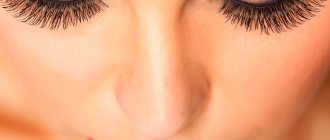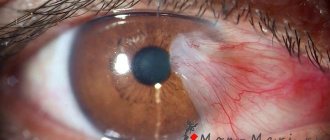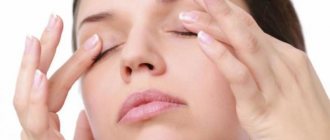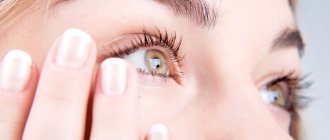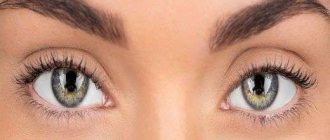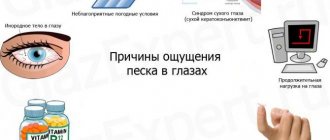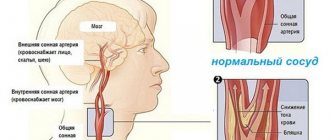Tearing from the eyes is a natural physiological process aimed at moisturizing the cornea and conjunctiva. In the normal state, a small amount of tear fluid is secreted, which goes unnoticed (does not flow down the cheeks). But with age, this process is disrupted and excessive lacrimation occurs. The reasons for this may lie in age-related anatomical changes, as well as in various disorders of the body, in some physiological processes. Excessive tearing in older adults can be treated in a variety of ways.
Features of lacrimation
Tears play an important role in the human body. They not only lubricate the surface of the eyeball, but also wash away pathogenic microflora and small foreign particles, and also protect the cornea from damage. Tear fluid is secreted through the lacrimal glands, located in the recess of the forehead bone. The secreted fluid washes the conjunctiva and accumulates in a special bag, after which it flows through the nasolacrimal duct.
To perform functions, only 1 ml of tear fluid per day is sufficient. Such tears are called physiological. Also a normal phenomenon that does not require treatment are emotional tears that arise at the psycho-emotional level (against the background of resentment, pain, laughter, joy, and so on).
In all other cases, increased lacrimation is not normal. Especially in old age.
Causes
Lacrimation in the elderly can be divided into 2 types:
- Retention. It occurs against the background of pathological changes in the performance of the lacrimal ducts.
- Hypersecretory. Appears as a result of excessive activity of the lacrimal glands.
In old age, increased tearing most often occurs for the following reasons:
- Wearing contact lenses for a long time or improper use of optics.
- Foreign body getting into the eye.
- Eye strain, fatigue.
- Allergic reaction.
- Side effects resulting from taking certain medications.
- Incorrect prescription of ophthalmic medications.
- Restoration of the visual organs after ophthalmological surgery.
Also, tearing on the street at any age can be a consequence of exposure to external unfavorable factors (wind, sun, frost, and so on).
Why do my eyes water?
Tearfulness can occur at any age, in adults and children. These may be physiological reasons that do not pose a danger and are caused by short-term factors:
- morning lacrimation caused by recovery processes - the production of tear fluid decreases at night and is reactivated in the morning;
- the body’s reaction to the bright sun, cold winter air, wind outside;
- getting cosmetics into the eyes that cause irritation or allergies;
- strong yawning or laughter - at this time the lacrimal sac contracts due to contraction of the facial muscles;
- visual strain, for example, from prolonged work with small objects or at the computer;
- age-related decrease in the tone of the eyeball - senile tearfulness;
- lack of vitamin B in the body, in the absence of which the sebaceous glands produce an increased amount of tear fluid;
- reaction to incorrectly selected glasses or contact lenses;
- a bite of an insect;
- entry of a foreign body under the eyelid.
All of the above reasons are not pathological and are temporary. Treatment with drops in this case will not be required. But the eyes can become watery due to other factors caused by the body’s reaction to any disturbances. In such a situation, consultation with an ophthalmologist is necessary, and then appropriate treatment. Here are some of the possible preconditions:
- inflammatory or infectious diseases of the eyes: blepharitis, conjunctivitis, dacryocystitis, barley, keratitis;
- allergic reactions;
- eye injuries of various origins;
- sinusitis, adenoviral infection;
- eversion of the eyelid, lagophthalmos;
- demodicosis and other diseases.
In such cases, only a specialist will be able to tell which drops are needed for treatment. You cannot prescribe medications for yourself, otherwise you can cause even more harm to your eyes. The fact is that these liquids are divided into different categories, each of which has a targeted effect on the cause of lacrimation. If you drip drops of another pharmacological group, the result will be side effects and a deterioration in the condition of the visual organs in general.
Watery eyes as a symptom of disease
Quite often in old age, lacrimation is pathological in nature, being a sign of one of the following diseases:
- dry eye syndrome;
- burn of the cornea;
- blepharoptosis (drooping eyelid);
- blepharitis (inflammation of the eyelids);
- keratoconjunctivitis sicca (reduced tear production);
- inflammatory processes (conjunctivitis, keratitis, uveitis);
- pathologies of ENT organs;
- colds;
- conjunctival dystrophy.
If lacrimation is pathological, then in addition to it, other unpleasant symptoms such as hyperemia, swelling, itching and burning in the eyes are observed. In very rare cases, excessive release of tear fluid may indicate the development of the following serious autoimmune disorders:
- Multiple sclerosis. A rare disease that has no specific symptoms. In many cases, weakness of the facial muscles is observed, resulting in facial distortion. The eye on the affected side of the face is not able to close completely.
- Systemic lupus erythematosus. Characterized by simultaneous damage to blood vessels and connective tissue. The mucous membranes of the mouth, lips and eyes are affected, and joint pain occurs.
- Rheumatoid arthritis. Can lead to complications in the form of increased lacrimation.
- Scleroderma. It is characterized by inflammation of small vessels, leading to thickening of the skin. In addition to tearfulness, there is increased sensitivity to light and aching pain in the joints.
If you have any other unpleasant symptoms besides watery eyes, you should consult a doctor as soon as possible. Especially if there is an increase in body temperature and signs of severe intoxication.
Causes of tearfulness in one eye
There are the following reasons why only 1 eye may become watery:
- the beginning of the spread of infection, which will subsequently be accompanied by other symptoms;
- viral disease caused by adenovirus, influenza, parainfluenza, herpes;
- entry of a foreign body;
- development of an inflammatory condition in the area of the cornea, conjunctiva, lacrimal sac, eyelid;
- foreign objects entering the lacrimal canal, causing infection;
- high blood pressure, progressing to the stage of hypertension;
- mechanical damage, minor burn, blow to one eye;
- postoperative condition, when the procedure was performed only for one eye;
- use of contact lenses not according to hygiene rules or mechanical damage to the edge of the lens in only one eye;
- neurological disorder, depression, severe stress, which affect the production of tear fluid, other symptoms may also develop (muscle twitching, drooping eyelid);
- the first sign of an allergy, which will then spread to both eyes.
Tearing of the eye may also occur for other reasons, so treatment is prescribed only after the diagnostic procedure has been completed by an ophthalmologist.
Anatomical changes that provoke increased tear production
With age, the functioning of all organs and systems is disrupted, including malfunctions in the lacrimal apparatus. At the age of 45-50 years and older, the organs of vision undergo anatomical destructive changes in tissues and systems. This leads to a thinning of the protective tear film, obstruction of the tear ducts and weakening of the eye muscles. Against the background of such changes, severe lacrimation occurs in older people even with the most harmless disturbances in the body’s functioning.
Lacrimation in older people usually occurs due to the following anatomical changes:
- Change of location of the lacrimal papilla. Due to degeneration of the skin and mucous membranes, the ocular papilla becomes longer and denser. The papilla ceases to participate in the drainage of tears, as a result of which the tear fluid does not enter the tubules, but simply flows down the cheeks.
- Changing the position of the lacrimal opening. As a result of decreased muscle tone, senile blepharoptosis develops, in which the lower eyelid droops and turns out. This leads to movement of the lacrimal punctum. Constantly wiping away tears leads to injury to the eyelid.
- Eyelash growth in the wrong direction. In old age, the eyeball sinks, the upper eyelid curls up, the eyelashes begin to irritate the mucous membrane, which leads to constant tearing.
- Atony (weakening) of the lacrimal duct muscles. As a result of weakening of the muscles, the function of tear secretion occurs, even if there are no anatomical changes in the visual organs.
If tearing appears against the background of an eversion of the eyelid, then the cause of this may not be an anatomical change in the tissue, but cancerous processes in the eyelids.
The main types of drops for tearing
Before choosing a drug, you must visit an ophthalmologist. The specialist conducts a comprehensive diagnosis to identify hidden causes of tearing. If an infection is suspected, additional tests may be required. Depending on the result, he recommends the following drops:
- Antibiotic based. They contain anti-inflammatory and antibacterial components, eliminate the cause, improving the condition of the mucous membranes.
- Anti-inflammatory. Used after surgery, injury, in complex treatment, relieve irritation and redness of the sclera.
- Combined. They contain various substances, relieve inflammation, and at the same time improve nutrition and blood supply to the organ of vision.
- Moisturizing. Recommended for maintaining balance when wearing lenses or working at a monitor for long periods of time.
In each case, the drugs are chosen individually. They are often combined with taking vitamin complexes, antibiotics and rinsing with an antiseptic.
A separate category of patients are people over 55 years of age. Due to natural reasons and age, the glands work with an increased reaction to any irritants. Watery eyes irritate the mucous membranes and visual acuity decreases. For inflammation, doctors recommend complex drops of Okomistin or Indocollir and prescribe a course of treatment to maintain the optic nerve.
With increased dryness while working at the computer, lacrimation often occurs in bright light and sunlight.
It is difficult for the eyes to adjust to the new spectrum, so a defensive reaction occurs. Hypersensitivity develops, which worsens in the wind and cold. In such situations, you can use Visin drops or other drugs with a moisturizing effect.
Read more Instructions for using Visallergol eye drops
Cationorm
This is a unique cationic emulsion to eliminate dry eyes, which does not contain preservatives, renews all layers of the tear film, providing long-term relief from intense discomfort. Cationorm prevents the development of dry eye syndrome and helps combat lack of hydration at any time of the day. Cationorm can be used directly on contact lenses. Indications for use:
- - pronounced or moderate dryness, even in the morning;
- - use of contact lenses;
- - eye diseases: glaucoma, blepharitis, allergic conjunctivitis.
When applied, Cationorm is evenly distributed over the ocular surface and does not cause discomfort.
Okutiarz
These are eye drops based on hyaluronic acid and do not contain preservatives. They are suitable for quickly relieving eye discomfort and fatigue that occurs at the end of the day or after intense visual stress. Ocutiarz can be instilled directly onto contact lenses. It is often prescribed to relieve discomfort after ophthalmic surgery on the cornea. Indications for use:
- - dry eyes in the evening;
- - eye fatigue after long visual work;
- - use of contact lenses;
- — the first 6 months after eye surgery (LASIK, PRK, cataract extraction).
Ocutiarz is well tolerated by patients, since hyaluronic acid is a component of natural tears and promotes healing of the ocular surface after ophthalmic surgery. Made in France. Shelf life 6 months after opening.
Oftagel
This is an eye gel with a maximum concentration of carbomer, which provides a feeling of long-lasting hydration, eliminates watery eyes and does not require frequent use.
Advantages of Oftagel:
- — optimal portability among gels due to a more fluid form;
- - one application per day is enough;
- — made in Germany;
- - low cost.
Oftagel is indicated for use by people with complaints of general discomfort, variable dry eyes, lacrimation and reluctance/inability to instill drops more than once a day.
Okomistin
The drug is an innovative antiseptic that eliminates inflammation and irritation. The drops contain an antimicrobial component with a pronounced antibacterial effect. Therefore, the drug is used in the complex treatment of infections caused by staphylococci, streptococci, herpes, and adenoviruses. It helps reduce lacrimation in the following diseases:
- conjunctivitis;
- keratitis;
- blepharitis;
- thermal burns.
Okomistin is recommended for complex therapy of rhinitis or sinusitis, eliminating swelling and pressure on the lacrimal glands. Used to prevent complications from otitis media, mycosis, and sinusitis. Suitable for treating children and women during pregnancy at any stage, safe during lactation.
Allergodil
It is recommended to use for increased tearing caused by allergic conjunctivitis. A drug based on azelastine has an anti-inflammatory and calming effect. It reduces capillary permeability, normalizes the functioning of receptors, eliminating the cause of irritation of the glands.
Among the disadvantages are frequent complications and side effects:
- increased swelling;
- skin itching;
- dizziness;
- muscle weakness;
- hives.
Allergodil drops are used in the treatment of children over 6 years of age, but are not allowed during pregnancy. They can be prescribed in long courses of 7–8 weeks, but an addictive effect gradually develops. It begins to act quickly after administration, allowing the patient to drive vehicles and do work without unpleasant lacrimation.
Read more Names and prices of drops for alcoholism without the knowledge of the patient
Octilia
In case of severe irritation and tear production, it is recommended to use alpha-adrenergic agonists, which relieve vascular tone, narrow their lumen, eliminating the cause of inflammation and discomfort. The active substance tetrizoline hydrochloride eliminates swelling and redness, linden and chamomile extract nourishes tissues, improving the condition of the mucous membranes.
Main indications for use of Octilia:
- complex therapy for conjunctivitis or blepharitis;
- irritation upon contact with chemical factors;
- work behind the monitor;
- recovery after surgery or injury.
Sometimes side effects occur in the form of increased intraocular pressure, itching and redness of the sclera. Contraindications are glaucoma, age under 3 years, diabetes mellitus and cardiac arrhythmia. Drops should be used with caution during pregnancy and lactation, and while taking antidepressants.
Tobrex
Therapeutic drops are broad-spectrum antibiotics. The base is boric acid, benzalkonium chloride and sodium sulfate. The combination of components relieves inflammation by disrupting protein synthesis and destroying pathogenic microflora. As the cause is neutralized, lacrimation and unpleasant symptoms decrease.
Tobrex can be used in the treatment of diseases caused by:
- Klebsiella;
- enterobacteria;
- salmonella;
- staphylococci.
Drops cope with increased lacrimation in severe infections, which are accompanied by suppuration and blockage of the lacrimal glands. Can complement systemic therapy for sepsis, sinusitis, meningitis, acute otitis media with edema of the appendages. Sometimes it provokes headaches, lethargy, and local allergic reactions.
Visine
Effectively eliminates increased lacrimation caused by dry eye syndrome. Contains the adenaline stimulant tetrizoline, which constricts blood vessels and reduces swelling of the conjunctiva. This reduces the formation of intraocular fluid for 6-8 hours after use.
Main indications for the use of Visin:
- irritation due to dry eye symptoms;
- contact with smoke, dust, chemicals;
- seasonal allergies.
Therapeutic drops are well tolerated, rarely cause side effects, and do not cause irritation. They can be used over a long course, but with careful adherence to the dosage. Otherwise, a reaction develops, which is accompanied by increased blood pressure, convulsions, indigestion, and nausea.
Cromohexal
When allergies worsen, doctors prescribe Cromohexal drops with the active ingredient sodium cromoglycate. It releases prostaglandins, which relieve discomfort, soreness and lacrimation. In addition, histamines act to stop the allergic reaction.
Cromohexal has a cumulative effect that manifests itself over several days. For preventive purposes, drops are used for dry eye syndrome. They are included in treatment for the following diseases:
- keratitis;
- keratoconjunctivitis;
- inflammation after injury.
Drops can be used from the age of 2 years no more than 4 times a day. The average course of treatment is 3–4 weeks. Not recommended during pregnancy, kidney or liver failure.
Lotoprednol
For blurred vision and lacrimation in older people, Lotoprednol drops are used. They moisturize and cleanse the cornea, relieve redness, itching, burning in blepharoptosis, Sjögren's syndrome, and blepharitis. They help eliminate side effects when taking certain medications for sclerosis or hypertension.
Read more Instructions for using Pilocarpine eye drops
Lotoprednol drops contain a hormonal component and the antibiotic tobramycin, which regulate the activity of the lacrimal glands and eliminate inflammation. Indispensable for allergies and severe swelling pressing on the optic nerve. In old age, Lotoprednol is not used for cataracts and glaucoma, exacerbation of herpes infection.
Not prescribed for children under 6 years of age.
Opatanol
A strong antihistamine based on olopatadine. It has a pronounced anti-allergic effect, relieves lacrimation in seasonal allergies. Opatanol drops calm serotonin and dopamine receptors, reducing swelling that puts pressure on the lacrimal glands.
In rare cases, Opatanol provokes side effects:
- blurred vision;
- burning;
- redness in the corners of the eyes;
- keratitis.
In rare cases, headache and runny nose may occur. For severe allergies, the course of treatment is 3–4 weeks. Drops can be combined with other medications for inflammation or pain. On average, symptoms of the disease and lacrimation disappear within 4–5 days.
Sanorin–Analergin
Drops with a pronounced vasoconstrictor and antiallergic effect. They contain naphazoline, an adrenergic agonist that quickly eliminates swelling and inflammation during exacerbation. Complete relief and reduction in lacrimation is observed on the 5th day. The inexpensive drug is not recommended in pediatrics for the treatment of children under 16 years of age.
Contraindications for use are:
- bronchial asthma;
- hypertension;
- angina pectoris;
- prostate tumors.
The drug blocks receptors that provoke allergies and the secretion of tear fluid. Therefore, it is necessary to observe the dosage so as not to provoke dry mucous membranes. In rare cases, it causes surges in blood pressure and tachycardia.
Lecrolin
Drops are used for lacrimation caused by allergies to pollen, animal dander, keratitis and conjunctivitis. Relieves symptoms when exposed to chemical irritants, side effects of cosmetics or eye mascara. Easy to dose, can be used up to 4 times a day.
Lecrolin is a cheap drug of good quality with a minimum number of contraindications. It is prescribed for the treatment of children from the age of 4 years, under the supervision of a doctor it is recommended for pregnant women. In rare cases, local allergic reactions occur in the form of burning, itching or redness of the sclera.
Lacrimation as a result of improper treatment and optical correction
Often in old age, tearing, pain and redness of the eyes occurs as a result of incorrect selection of optics or the use of ophthalmic drugs for other purposes. In addition, increased lacrimation may occur as a result of uncontrolled use of medications. Sometimes this unpleasant phenomenon is a side effect of drug or surgical therapy.
It is very important to treat eye diseases strictly under the supervision of an experienced doctor.
Diagnostic methods
If you complain of excessive tearing in old age, you should consult an ophthalmologist. After collecting a detailed history, taking into account all the accompanying signs, the doctor will make the correct diagnosis and select effective treatment. To identify the exact cause of tearing, the following diagnostic methods are used:
- ophthalmoscopy;
- biomicroscopy (slit lamp examination);
- samples using medical dyes;
- radiography.
Read in a separate article: What is eye scotoma, causes and treatment
If serious diseases are suspected, additional laboratory and instrumental diagnostic measures may be prescribed. If during an examination by an ophthalmologist no abnormalities were identified, then a comprehensive examination is necessary to identify autoimmune disorders.
Differential diagnosis with diseases of an allergic, colds and other nature is required.
Allergic reaction
Exposure to allergens on the mucous membrane can also cause the eyes to sting. Allergies often cause conjunctivitis. At the same time, it is quite easy to distinguish irritation from allergies. When an allergy occurs, the eyes will sting until the irritant is completely eliminated. Allergic conjunctivitis is usually accompanied by watery, swollen, and red eyes. To treat an allergic reaction, an integrated approach is used. The most effective are drops that relieve irritation of the mucous membrane, as well as antihistamines that suppress the allergic reaction. In addition, to eliminate the symptoms of irritation, it is necessary to pay attention to a properly balanced diet.
Summarize. There are three reasons why your eyes may sting and water profusely. This is an external irritant, the spread of infection and an allergic reaction. Temporary irritation is the mildest case. To get rid of irritation, just rinse your eyes with water. If the cause of irritation is an allergy, it is enough to eliminate the allergic component. If the discomfort is due to an eye infection and your eyes have been stinging for several days, you should definitely consult an ophthalmologist.
The Vision Restoration Center employs doctors with more than 10 years of experience. Our clinic has an excellent reputation - thousands of patients undergo treatment with us every year. The medical center is equipped with modern diagnostic equipment. Another advantage of contacting us is an individual approach to treatment. We conduct a thorough examination, establish an accurate diagnosis and prescribe individual therapy.
Are your eyes stinging? Tired of unpleasant sensations? Don’t delay solving this problem - make an appointment with an ophthalmologist right now!
What are the dangers of tearing?
Tearing in older people is a common occurrence and does not pose any danger in itself. However, the danger may be hidden in the primary pathological processes that provoke it. In addition, increased tear production leads to a thinning of the tear film, as a result of which the protection of the surface of the eyeball is weakened. This increases the likelihood of foreign bodies and pathogenic microorganisms entering the eye.
Increased production of tear fluid can cause the following complications:
- leakage of pus;
- keratitis;
- severe pain in the eyes;
- sinus congestion;
- blurred vision.
As a result, this can lead to bacterial infection and involuntary eye injury. Increased tearing in old age is especially dangerous for people with diabetes, since in this case such an unpleasant symptom may indicate the development of severe complications, including complete blindness.
Why the eye may become red and watery
If you notice that one of your eyes is watering, the first questions that may arise are what to do, how to treat and what to treat. However, the first thing that needs to be done is to treat lacrimation by eliminating associated irritating factors that may cause it.
For example, if one eye is red and watery, then you need to check whether a foreign body in the form of an eyelash or other debris has entered it. If all blockages are excluded, then tearing may be a sign of some serious disease, which only a doctor can determine. This is due to the fact that any alarm signals from the body and directly from the organs of vision are not a joke and it is strictly forbidden to let this process take its course.
If there is very strong redness of the eyeball, this is due to the fact that inflammation of the vascular formations that are located inside the sclera has occurred. In a calm state, these vessels are practically invisible, and the sclera has a characteristic white color. The reasons that precede redness can be both internal and external. External reasons. In this case, swelling and inflammation of the eyeball may be preceded by the following negative factors:
- negative environmental impact;
- entry of foreign bodies;
- exposure to contact lenses;
- allergic reactions, lacrimation, the treatment of which is reduced to eliminating allergens;
- traumatic conditions of the cornea;
- inflammation of the optic nerve.
Internal factors. These are reasons, of which there are relatively many. Almost all pathological processes that occur in the human body can become precursors to vision problems and eye inflammation. These problems can be cured and eliminated by eliminating the underlying disease that affects vision. In such situations, the redness usually spreads to both eyes, although a unilateral process can sometimes be observed.
Drug treatment
The treatment strategy for lacrimation in older people depends on the diagnosis. In some cases, it is enough to eliminate the effects of adverse factors, while in others it is necessary to use certain medications. Depending on the underlying problem, the treatment regimen may look like this:
- Foreign body getting into the eye. Rinse the eye well, carefully remove the speck and apply anti-inflammatory eye drops to prevent watery eyes.
- Eye fatigue. Normalize your work and rest schedule, give up sitting at the computer and TV for a few days.
- Allergic reactions. Try to avoid contact with allergens and take antihistamines.
- Wearing contact lenses. Change lenses or replace them with glasses.
- Ophthalmological diseases. Use special medications and, if necessary, undergo a course of physical therapy. In severe cases, surgery is needed.
If lifestyle changes do not help, then appropriate drug therapy is selected. The main dosage form in this case is eye drops for lacrimation. Depending on the type of problem, the following groups of drugs may be prescribed:
- antibiotics: Okomistin, Indocollir;
- corticosteroids: Lotoprendol;
- antihistamines: Azelastine, Patanol;
- vasodilators: Vizin, Nafkon-A.
For elderly people with increased tearing, the following eye drops are most often prescribed:
- Allergodil;
- Cromohexal;
- Ciprofloxacin;
- Levofloxacin;
- Prenatsid.
Many medications have a number of side effects and contraindications, especially in old age. Therefore, self-medication is strictly not recommended; all medications should be selected exclusively by a doctor. You cannot use more than 3 ophthalmic products at a time.
The break between instillations should be 10-15 minutes.
TOP 10 best anti-tear medications
If your eyes are itchy and watery, you need to know what to do and what drops to choose. In this section, we will look at the anti-tear drops that doctors recommend first.
Oftagel
Eye gel with carbomer in maximum concentration, created to eliminate compensatory lacrimation in dry eye syndrome, moisturizes for a long time and does not require frequent use, it is enough to apply the gel once at night, the eyes will be sufficiently moisturized throughout the next day. Oftagel can be bought from 280 rubles.
Cationorm
The only cationic emulsion in Russia, containing mineral oils, without preservatives. Cationorm restores the lipid layer by reducing tear evaporation and stabilizing the tear film. Prescribed for severe symptoms of dry eye syndrome, such as lacrimation, itching, burning in the eyes. The use of Cationorm drops helps prevent further development of the disease.
Okutiarz
Drops based on ultra-high molecular weight hyaluronic acid are recommended for occasional dry eyes, to eliminate dryness, eye fatigue and lacrimation. The drops do not contain preservatives and can be used in conjunction with contact lenses. Ocutiarz is very often prescribed to relieve discomfort after ophthalmic surgeries such as LASIK, PRK, and cataract extraction. The price of drops is about 500 rubles.
Sanorin Analergin
Vasoconstrictor eye drops for lacrimation "Sanorin Analergin" are prescribed to reduce the manifestations of allergies. They belong to combination drugs that combine an alpha-adrenergic agonist with an antihistamine. This combination allows you to quickly narrow blood vessels, block allergic processes, and relieve pathological symptoms. The cost will be about 250 rubles.
Video: Sanorin-Analergin - indications for use
Octilia
Anti-lacrimation drops "Octilia" are alpha-adrenergic agonists and can narrow the lumen of blood vessels. Due to this, a positive effect is achieved with signs of irritation, redness, and watery eyes. Recommended for conjunctivitis and increased dryness of the mucous membrane. The average cost of Octilia is 300 rubles.
Tobrex
Bacterial eye diseases are treated with the topical Tobrex. It belongs to antibacterial drugs. "Tobrex" helps to cope with the symptoms of inflammation, is effective in treating teary eyes, the effect of the drops can be enhanced by moisturizing and anti-inflammatory agents. Treatment will cost 150–200 rubles.
Lotoprendol
For severe inflammatory or allergic manifestations, Lotoprendol is prescribed. “Lotoprendol” eye drops are classified as hormonal agents from the group of glucocorticosteroids, so they quickly relieve the symptoms of lacrimation, redness, and swelling.
Opatanol
Opatanol drops are effective if an adult’s eye is watering due to an allergic reaction. It is imperative to exclude the allergen, otherwise the positive effect will be short-term and weakly expressed. Approved for use in children over 3 years of age. "Opatanol" costs about 500 rubles.
Video: Opatanol - instructions for use
Allergodil
Manifestations of allergies are quickly relieved with Allergodil drops. They belong to the group of antihistamines. For use in adults and children over 4 years of age. Estimated cost 500–600 rub.
Visine
Popular drops for the treatment of tearing caused by irritation, allergies or eye fatigue are Visin. The drug "Vizin" belongs to alpha-adrenergic agonists. It has a vasoconstrictor effect, relieves discomfort, and moisturizes the conjunctiva. The price of the drug ranges from 200–500 rubles.
Lecrolin
Lecrolin drops are recommended for use when the eyes become watery after contact with an allergen. The antihistamine effect of the drug is to relieve symptoms such as redness, lacrimation, and swelling. The approximate cost of "Lecrolin" is 100 rubles.
Video: Lecrolin - video instructions, indications, description, reviews, dosage
Prenatsid
For severe clinical manifestations of allergy or inflammation, Prenacid is prescribed. To prevent your eyes from watering and reduce unpleasant symptoms, it is enough to drip the product several times. It belongs to glucocorticosteroids, so the effect occurs as quickly as possible. Prenacid is contraindicated for children, pregnant and lactating women. The price starts from 200 rub.
Cromohexal
To help if your eyes are very watery and itchy due to an allergic reaction, inexpensive drops against allergic lacrimation “Cromohexal” will help. They quickly relieve allergic manifestations due to the antihistamine effect. The price of 1 bottle is within 100 rubles.
Treatment with folk remedies
If the main problem is not serious, then you can cope with excessive tearing with the help of folk remedies. Among the most effective and safest recipes are the following:
- Dill seeds. Pour a tablespoon of seeds with cold water, boil and let it brew for a couple of hours. Before going to bed, wash your face with the resulting decoction, and then make a compress with it on your eyelids for 10 minutes. The course of treatment is at least 14 days.
- Aloe. Wash the fleshy stems, chop and squeeze the juice from the resulting pulp. This juice should be used as an eye lotion.
- Lily of the valley flowers. Pour a glass of boiling water over a teaspoon of dried flowers and leave to steep for 40 minutes. After the time has passed, soak cotton pads in the infusion and apply compresses to your eyes.
- Millet. Take 50 g of washed raw millet, pour 700 ml of boiling water over it and let it boil for 5-7 minutes. Drain the water from the millet, strain it and use it to wash your eyes three times a day. For the best effect of the infusion, it is recommended to apply a compress to your eyelids at night.
- Medicinal collection. Take a teaspoon each of dried eyebright herb, plantain seeds, cumin and cornflowers. Pour 250 ml of boiling water over the herbal mixture, boil for 5 minutes and let it brew for 24 hours. Strain the infusion and use as eye drops 2-3 times a day.
Before starting treatment with folk remedies, you should consult a specialist.
Treatment
Medicines
Tearfulness is treated with drops and ointments. First you need to contact an ophthalmologist and find out the cause, only then look for a way to solve the problem.
For colds, no eye medications are needed. When the acute cold passes, then the increased secretion of fluid from the eyes will disappear.
If the cause is an allergic reaction, antihistamines and anti-inflammatory drugs are prescribed. You will also need to avoid the irritant that provoked such a response from the immune system.
For infectious diseases, antibacterial, anti-inflammatory ointments or drops are prescribed. For example, Tetracycline, Hydrocortisone, Erythromycin.
If a person has to work for a long time in the wind, in a dusty or smoky room, the best solution is moisturizing eye drops. Systane, Vidisik, Cationorm, and Artificial tears have proven themselves well.
If the visual organs are overstrained, it is recommended to take breaks from work, perform simple eye exercises, and observe a work and sleep schedule.
Folk remedies
Traditional methods of treatment are welcome in ophthalmology, but they should not be abused. Self-treatment with folk remedies for the eyes is prohibited; all chosen methods of home therapy must be discussed with your doctor.
Folk remedies:
- Crush propolis in warm water. Infuse until a yellowish aqueous solution is obtained. Filter through sterile gauze. Place 2-3 drops into each eye.
- For allergic conjunctivitis, use 2 tbsp. l. thyme steamed in 250 ml of boiled water. Place the product in a water bath, simmer for 15 minutes, leave, strain and use for eye applications.
- Prepare a strong infusion of rose petals. Leave for 1 hour, strain and use the liquid for rinsing 2 times a day.
- If tears flow heavily, apply cotton swabs soaked in a warm decoction of dill seeds before going to bed. The procedure lasts 10 minutes.
- Blue cornflower flowers help get rid of the symptom. They are poured with boiling water, infused, and the solution is filtered. Use the medicine for lotions and rinses.
Decoctions of chamomile, calendula and string are effective for infections. The eyes are washed with solutions 3 times a day.
Operation
Surgery is a last resort measure that is used when the lacrimal ducts are narrowed or completely obstructed. Surgery is also used for inversion or inversion of the lower eyelid.
The operation is aimed at restoring the lacrimal openings, canaliculi and nasolacrimal duct. After it, the patient is also prescribed medications to prevent the development of infection and speed up recovery.
Surgical intervention
In advanced cases, in particular with significant anatomical destructive changes in the tissues of the eye, surgical intervention is necessary. Most often, surgery is prescribed in the presence of the following disorders:
- stenosis of the nasolacrimal duct;
- eversion of the lacrimal punctum;
- retention cyst of the lacrimal sac;
- formation of dacryolites;
- blockage of fluid outflow channels.
The type of surgery depends on the cause of the pathology.
Prevention
You can prevent the occurrence of lacrimation in older people by observing the following preventive measures:
- eat right (include in your diet as many foods as possible rich in vitamin A);
- observe work and rest schedules;
- to live an active lifestyle;
- avoid eye strain;
- maintain personal hygiene;
- choose the right optical correction;
- sleep at least 6-8 hours a day;
- go outside wearing sunglasses;
- do gymnastics and eye massage daily;
- avoid interaction with allergens;
- wipe away any tears with clean tissues.
It is necessary to regularly visit an ophthalmologist for preventive purposes and, when the first signs of eye pathologies appear, immediately consult a doctor.
